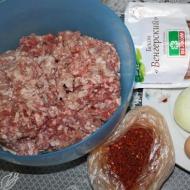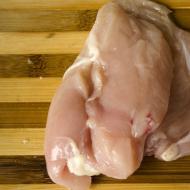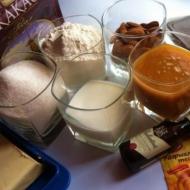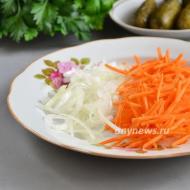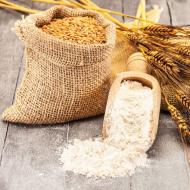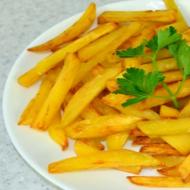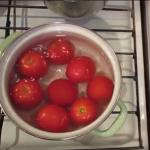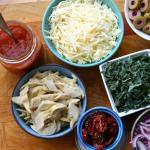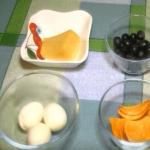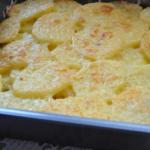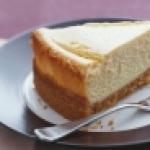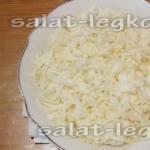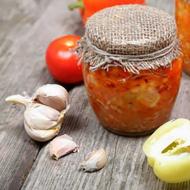
Intoxicating mead recipe. Mead: how to make it at home. Boiled spicy mead
Mead is a low-alcohol drink that has an amazing taste and has a healing effect on the body. It has long been particularly popular and is produced in countries where grapes do not grow.
In Rus', not a single feast was complete without “drinking honey.” Visiting merchants and foreign guests especially valued mead, since at home they could not enjoy such a drink, which was used not only to lift the spirits, but also to improve health.
When prepared correctly, the mead, unlike vodka, could not make one's head go crazy and provoke alcoholism. It received this name due to the fact that it matured (stood) in cellars for a long time (up to 50 years). Quite often, an oak barrel with a preparation was buried in the ground at the birth of a son, and dug up for his wedding. The minimum aging period is 5 years.
Traditionally, mead was made without yeast or water. To prepare it, they used cold honey and fermented berry juice (raspberry, strawberry, cherry) or raisins. Hops were occasionally added. Only in the 18th century did recipes with yeast appear.
Ordinary mead is not particularly strong: it contains only 4 degrees. For the holidays, they prepared a stronger drink (up to 10 degrees). But some recipes for mead without yeast made it possible to obtain a higher strength (up to 21 degrees).

How to make mead without yeast and boiling? There are several recipes that can be used to prepare this ancient drink. Of course, it will be inferior in taste to the ancient Russian mead, since no one in our time will leave the drink to infuse for several decades. But even in this case, homemade mead without boiling will be very tasty and healthy, since it contains only environmentally friendly products.
The drink not only has a pleasant taste, but also lifts your spirits, successfully fights colds and other diseases, strengthens blood vessels, improves cardiac activity, boosts immunity, normalizes the functioning of the digestive system, restores sleep, has an antipyretic effect, relieves hangovers, and removes toxins.
In small quantities, low-alcohol mead will benefit even pregnant women.

FEATURES OF PREPARING MEAD WITHOUT YEAST AND BOILING
So, how to properly prepare mead from honey without yeast at home? First of all, you need to learn the basic rules:
*honey is used cold, it is not boiled or heated - due to the lack of heat treatment, all useful substances remain in their original form, which allows you to increase the benefits of the product many times over;
*you can take any honey, even heavily sugared (in this case it is diluted with warm, but not hot, water), but it is best to use linden honey - it is softer than other varieties and is easier to ferment;
*water must be of high quality (if possible, preference should be given to spring water or purified water, but not distilled);
*first dilute honey with water (if necessary), and then add berries to the mixture, hops are added last;
*do not add yeast or other artificial additives - they worsen the quality of the drink and completely change the taste, making it unrecognizable;
*if desired, natural flavor enhancers (berries, aromatic herbs, spices, seasonings) are added to the preparation;
*the role of starter is played by berries, raisins, bee bread, and sprouted wheat (it must be sprouted in advance);
*the container must be perfectly clean;
* the future drink is stirred regularly so that it acquires the same consistency;
*for infusion, the “honey pot” is placed in the cold, preferably in the basement, or buried in the ground.
Making mead without yeast does not require much work. Simply mix all the ingredients and place the starter in a warm place. Fermentation (it begins on the third or fourth day) will take about two weeks. When the drink stops fermenting, it is filtered, poured into a container for storage and left for 4-5 months.
The quality of “nutritive honey” depends on the duration of fermentation. Therefore, you should not rush to drink the drink, it is better to let it brew well. The color, aroma and taste of mead depends on the type of beekeeping product used. Linden honey will give a sunny color and transparency, buckwheat honey will give a dark amber color, and floral honey will give a pronounced aroma of flowers.

RECIPES AND COOKING INSTRUCTIONS
To make mead at home, each ancient brewer used his own ingredients. Let's look at several recipes without yeast.
WITH SPROUTED WHEAT
The no-boil mead recipe contains the following ingredients:
*honey (preferably linden) - 1 kilogram;
*water (preferably spring water) - 2-3 liters;
*sprouted wheat - you will need a handful of wheat per liter of drink.
First you need to germinate the wheat (the process will take 2-4 days). Then all the ingredients are mixed, after grinding half of the sprouted grain. Leave in a warm place to ferment. When the mixture has fermented, it is filtered, poured into jars and placed in a cool place. The longer the drink infuses, the more aromatic it will become.
OLD RECIPE
To prepare mead according to an old recipe, you need to take:
*honey - 1 kilogram;
*berry juice - 2 liters;
*spices - to taste;
*hops - 50 grams.
All ingredients are thoroughly mixed and left for 2 weeks. Instead of juice, you can take berries mixed in water in a 2:1 ratio.
After the end of active fermentation, the drink is filtered and placed in a hermetically sealed container for fermentation and residual fermentation. You will be able to taste the honey drink in 4 months. It will perfectly quench thirst and have a tonic effect.
You can also use another recipe:
*water - 2 liters;
*honey - 400 grams;
*hops - tablespoon;
*cardamom - a tablespoon.
Bring the water to a boil, add the hops and leave on the fire for a few minutes. Honey and cardamom are added to the cooled liquid and left in a warm place to ferment. The strained mead is then bottled, sealed and refrigerated for several months.

MODERN RECIPE
In addition to the classic ones, modern recipes are also known, characterized by shorter aging periods. To prepare the drink, use hot water, yeast, and apple or pear juice. In this case, it looks more like honey moonshine. Although such a drink has a pleasant taste, unlike mead, it will not bring benefits to the body.
Therefore, it is better to take sweet berries (strawberries, raspberries, blackberries, currants, cherries, cherries, grapes) instead of yeast. If the berries have too thick skin, they are rubbed through a sieve or passed through a meat grinder. A similar recipe will allow you to get low-alcohol (2-4 degrees) honey wine.
For those who prefer stronger drinks, we suggest using the following recipe:
*honey (preferably buckwheat or lemon) - 500 grams;
*water (purified) - 2 liters;
*vodka (good quality) - 0.5 liters;
*spices (cinnamon, cloves, anise or nutmeg) - to taste.
Honey is dissolved in warm water and boiled for 10 minutes, but without boiling. Add spices and leave until cool. Vodka is poured into the resulting cooled mixture. Then everything is filtered and placed in the cold for 2-3 months. This mead has a sweet taste, unusual aroma and beautiful color.
RECIPE FOR PERGA
*honey - 300 milliliters;
*water - 2 liters;
*breadbread - 100 grams;
*raisins - 100 grams;
*juice from two lemons;
*cinnamon (optional).
Honey is thoroughly stirred in warm water, the remaining ingredients are added.

When fermentation stops, the strained mead is left in the cold for 3-4 months.
RECIPE WITH CHERRY
For the drink you will need:
*water - 1 liter;
*honey (preferably linden or buckwheat) - 2 kilograms;
*cherries - 4 kilograms.
Honey is dissolved in cooled boiled water. The resulting solution is poured over the berries (there is no need to wash them to ensure active fermentation thanks to “wild yeast”). After fermentation has stopped, the drink is filtered, poured into a hermetically sealed container and refrigerated for 3-4 months.
ON RAISIN
To prepare mead with raisins, you need to take:
*water - 1 liter;
*honey - 50 grams;
*raisins or ripe grapes - 50 grams.
The water is boiled and left until it cools. Then honey is dissolved in it, raisins are added and left to ferment in a warm room. The filtered drink is left to infuse for several more months in the cold. It has a pronounced floral aroma and low strength (3-4 degrees).
You can use another recipe:
*water - 1 liter;
*honey - half a liter;
*berries - 2 kilograms;
*raisins - 50 grams or bee bread (100 grams) - you can take both ingredients.
This recipe allows you to make fairly strong mead (up to 16 degrees). If you want to get a weaker drink (up to 10 degrees), reduce the amount of bee bread or honey.

WITH APPLE JUICE
For mead you need:
*water - 2 liters;
*honey - 1 liter;
*apple juice (freshly squeezed) - 1.5 liters;
*cinnamon and other spices - to taste.
Honey is dissolved in warm water, apple juice and spices are added. Leave to ferment for 2 weeks, then filter and refrigerate. If you are planning a big holiday, it is better to increase the amount of ingredients.
VIDEO - Mead. No yeast and no boiling!
Many have heard or read about mead, some have even tried it. This alcoholic drink is usually associated with something ancient, coming from the gray years of the history of our country, but this is not at all the case.
Mead, depending on preparation, can be pleasantly sweet with a small degree (10-16) to very high (70), in the latter case it is used more for external than for internal use.
Nowadays, there are a huge number of mead recipes with which we can prepare it at home, there are “old” and more recently created versions of this alcoholic drink. You should also not forget that even though the strength of mead is relatively low, due to the nature of honey, it is also very insidious, and while your head will be clean, your legs will not go anywhere. Read about this and much more further in the article.
Description
Mead– an alcoholic drink made from honey, yeast and flavorings.
Mead is considered one of the most ancient drinks; it was often prepared in Rus'. Not a single celebration would be complete without this alcoholic drink.
Honey was a medicinal product, so mead with known beneficial properties was prepared from it. Also, people were already familiar with the so-called “drunk honey” - bees obtained this beekeeping product from the nectar of azalea, heather, rhododendron and other plants.

Honey received this name because it contained a toxic substance - the glycoside andromedotoxin. Under the influence of this substance, a person became drunk, experienced dizziness, and sometimes nausea or convulsions.
The popularity of mead, as well as other non-alcoholic honey drinks, is due to the fact that honey was a common product; at least a little of this beekeeping product could be found in every home.
Scientists even suggest that the technology for producing mead is much older than winemaking technology.
- The first mentions of mead date back to 7-6 thousand years BC. e.
- At this time, the production of a similar drink was established.
- The stages of making mead are depicted on the walls of tombs in Egypt.
- The ancient Egyptians considered it a drink of divine origin.
- The Slavs believed that only gods and great ancestors were worthy of drinking a honey drink.

How the first mead was made
The very first mead in Rus' was produced by fermenting honey in barrels with berry juice. The recipe for this drink was discovered in the widely known Domostroy (880). The cooking process was quite complicated and also took a lot of time. The fact is that initially mead was made without adding yeast, so the process was very slow. Fresh honey was mixed with sour berries and left to ferment.
To make mead, honey was fermented for 15-20 years. Sometimes fermentation reached half a century.
This kind of honey was called “staged” because it stood for a long time. For this purpose, honey was sealed in barrels, sometimes they were even buried in the ground. This was the recipe for making traditional mead. Since the process was very complex and also costly, only representatives of the rich classes, princes or warriors could afford such a drink.
Barrels of mead were given to newlyweds as wedding gifts; it was considered a very valuable gift. This drink made it possible to have fun at a wedding for a long time and not get too drunk. The strength of the mead was 8%-12%, and its taste was very delicate and sweet.
In order to simplify production, a technology for producing intoxicated and boiled honey was invented. “Intoxicated Honey” appeared 50 years later than it was staged. In addition to adding juice, they began to add hops and spices to this product so that the drink had greater strength and a pleasant taste.
- Intoxicated honey was prepared for a total of 3 years; it could stand for 5-8 years.
- This drink came to Rus' from Scandinavia, where honey drinks have been in high esteem since pagan times.
- It was believed that honey was sent to people by the gods; it was food for warriors and poets.
- The drink had a somewhat tart taste with a slight bitterness, but it was still much tastier than beer.

"Boiled" honey
The next stage in the preparation of mead was the production of the so-called “boiled honey”. The first mention of it dates back to the chronicles of 996. The production of this drink was no longer so difficult; any family could afford it. First, honey was dissolved in enough water to release the sugar, then fermentation began.
The honey was left to ferment for 3-7 days, then poured into containers and kept in a dark place for a week or a month.
This method made it possible to significantly reduce the amount of waste during the production of the drink. The drink made from boiled honey tastes a little like beer. It was only prepared for a few weeks.
Over time, new principles for making honey drinks appeared, which were soon replaced by vodka and wine. The revival of these recipes began already in the 19th century, by which time many traditions had been forgotten.
For example, a very honorable dish in Rus' was “syt” - a sweet drink that was served at the end of the meal. It was from this time that the phrase “eat your fill” came about, that is, eat everything, leaving room only for “fullness.”
Honey in Rus'
Honey has always been held in high esteem in Rus'. It was considered a sacred product, at one time it was even used instead of wine for communion. Before the meal, they consumed the so-called “sbiten”, which is produced by boiling honey in water with the addition of juice and spices. There was also a digest - a mixture of beer and honey. Perevar was considered the lowest quality product that even the poorest people could afford.
- In Mordovia they prepared the so-called “pure”, it was a drink whose production methods were similar to those of making wine and beer. The main ingredient of “pure” was honey.
- Honey was also added to fruit and berry wines. In Ethiopia, honey drinks were called "tej". This is a homemade drink. Its strength is 15%-30%. It has a sweet and spicy taste.
In the 19th century, new recipes for preparing honey drinks were invented. They were diluted with water, and also mixed with vodka or alcohol, beer. It was in the 19th century that the drink began to be called “mead”, and before that it was called “drinking honey”. The next stage in the development of mead was the arrival of the USSR. Mead was now understood as an industrially produced drink, only vaguely reminiscent of an original Russian product.
How was mead prepared in Rus'?
At first, the honey drink in Rus' was simply called “honey”, “nutritious honey”, “intoxicating honey”. It was prepared in a special way: for a long period (from 5 to 20 years), honey was buried in oak barrels in the ground, and after fermenting, it turned from natural unsterilized honey into “staged honey.”
Later, from the 11th century, they began to use another method of preparing a honey drink - they began to boil it. This honey drink, sterilized by boiling, could be consumed within a month.
Gradually, the method of preparing honey drinks using the honey method disappeared. And since the 17th century, they practically stopped making mead (wine replaced honey). Along with this, the ritual of eating honey before meals also disappeared. And only by the 19th century they began to remember old recipes again and various drinks made from honey reappeared.
Stewed honey - an ancient recipe for mead
This honey drink was considered the most valuable and high quality. True, it took a long time to prepare it.
Mead was prepared without boiling, using a special fermentation method.
- First, the honey was fermented.
- Any sour berries were good for his starter: lingonberries, cherries, currants.
- Hops were added less frequently.
The honey-berry mixture fermented for some time at a temperature of 5°C. After the end of fermentation, the barrel was sealed, filled with tar and buried in the ground for a long time. The mead turned out noble and seasoned. Its production period is at least five years. And sometimes he reached 40-50 years.
The taste depended on the aging period. By the way, it could easily be spoiled by a small amount of tar, which could get into the barrel through loosely fitted boards when the barrel was clogged. This is probably where the expression “fly in the ointment” comes from.

Boiled mead – hearty honey
The prepared honey, with all its advantages, had one big drawback - it was necessary to wait a very long time for the aromatic drink to ripen. And it wasn't cheap. Apparently, this is why, already at the end of the 11th century, another ancient recipe for making mead, obtained as a result of boiling, sterilization and fermentation, appeared.
They began to brew the honey drink. And those who cooked it began to be called mead makers. The drink was prepared much faster (within a month) and was cheaper. This drink, of course, was much more affordable than standard honey and quickly gained popularity.
To prepare it, spices, herbs, and fruits were added to honey dissolved in water to taste.
- Then it was boiled, and after cooling, yeast was added to it to leaven (by this time they had already been invented) and kept cold in a glacier until fermentation reached a certain stage.
- After which came the last stage in the preparation of Russian boiled mead - it was settled, clarified and kept for a short time.
Mead "simple"
The closer to our time, the simpler and more primitive the ancient mead recipe became. They stopped fermenting the honey itself. First, they prepared a mash from berries or fruits, adding spices, herbs, roots and honey to it.
This is where “mead” actually appeared.
It was understood that this was the same old intoxicating drink, but of lower quality, because as a result of such a simplified technology for its preparation, the soft and delicate taste of boiled and stored honey was lost. Their pleasant aroma was overwhelmed by the smell of yeast and fusel oils.
But it is precisely this name, essentially negative, that since that time has been firmly associated with all ancient alcoholic drinks prepared on the basis of honey.
How many degrees is there in mead?
The drink differs in strength and production time: regular mead, young mead, set mead, strong mead. The strength of mead depends on the infusion temperature, holding time, the quality and type of accompanying components, and conditions after filtration.
In ancient classical recipes, which did not involve the use of yeast and chemical additives, the percentage of alcohol should have been minimal (5-6%). It goes without saying that using them and adding ready-made mash is already a deviation from the classic recipe.
However, mead can be not only alcoholic. There are also known recipes for a non-alcoholic drink, more similar to honey kvass, which is produced by skipping the main fermentation stage. You can, if desired, add honey and alcohol to the finished mead.

How to make mead according to an old recipe?
There are a lot of ancient recipes for mead and options for its preparation. Depending on the composition of the ingredients, it can be mead with juniper, with cinnamon and ginger, with pepper and horseradish, with raisins and cloves, with cherries and nutmeg, mint or rose hips.
Of course, many original Russian recipes have now been forgotten and lost. And those partially preserved ones that we use have been rethought by us from the point of view of modern man. But this does not in the least prevent us from enjoying the delicious drink of our ancestors.
Many people would like to try real honey, but to do this, at a minimum, you need to travel back to the times of the Russian princes and find yourself at one of their feasts.
- It will not be possible to repeat exactly the technology for preparing cold honey at home.
- We don’t have oak barrels or glaciers, and not everyone has the patience to wait so many years for a finished drink.
- But you can use the second old method - brew mead.
Recipe:
- Honey – 1 kg
- Water – 2.5-3 liters
- Spices (ginger, allspice, cardamom, cinnamon) – 10 g
- Hops – 5 g
- Zest of one lemon
To prepare boiled mead according to an old recipe, add water to the honey and bring to a boil, stirring. Add spices, hops, lemon zest and boil again, removing any foam that forms.
After the broth has been filtered and cooled, you need to add 100 g of yeast (beer, wine, bread) to it and leave to ferment in a warm place for 1-3 days. The bottled drink will mature in a dark, cool place.
How to drink mead?
- Mead-making experts advise drinking mead before meals. In any case, this is how our ancestors drank intoxicating honey in Rus'.
- The drink is served chilled. You should not drink it or eat it. But if you like to use it in a different way, there are no strict rules on this matter.
- Mead is not a strong drink, but it is insidious. The drink is quickly absorbed into the blood. Hence the amazing effect familiar to many: the head is sober, but the legs don’t move. But if you drink mead in small quantities, the state of intoxication quickly passes.
behoneybee.ru
The modern recipe for mead appeared in the 18th century in Veliky Novgorod and became popular in the 20th century. During the Soviet era, honey collection technology was often violated, collecting it earlier than necessary. This unripe honey was poorly stored and was absolutely not suitable for sale. Therefore, a cunning way of using illiquid stock was invented - fermenting this honey with baker's yeast. Suzdal and Veliky Novgorod were famous for their mead making. The strength of mead from Veliky Novgorod is from 5 to 16%. In Suzdal you can find more than ten types of mead, which differ in strength and spices. Dried ginger root, juniper berries, cinnamon sticks, cloves, rose hips and hot pepper are often added to mead here.
Ripening period
In the standard recipe, the fermentation process of mead lasts five days. It looks like cloudy champagne. Sometimes mead is infused for three to six months.
It becomes less sparkling, but more aromatic, strong, fluid and dense. If you add berries to mead, it will become healthier over time - the berries will give up their beneficial substances to the drink. Depending on the recipe, the strength of mead can vary from two to ten degrees.
Fermentation process
During fermentation, a large amount of gases are released, so you can’t just take a jar with mead and seal it with a lid - it will definitely explode.
You can cover the bottle with a cloth, but it is better to make a special gas outlet from the cap with a hole in it.
You need to insert a thin hose into this small hole. One side of the hose should be in the bottle on top of the liquid, and the other should be lowered into a bowl of water. This way, gases and fermentation products can safely escape from the drink. 
The most delicious mead is made from high-quality aromatic honey. Light varieties are best; the optimal choice is white acacia or linden honey. Mead with a pronounced taste is made from buckwheat honey - a brown aromatic drink with a slight bitterness.
- Hop cones for mead can be found in any pharmacy.
- The foam that forms when cooking honey must be skimmed off. Then the drink will turn out transparent.
- Before dissolving yeast in honey syrup, the drink must be cooled, since yeast does not live at temperatures above 50 degrees.
Be careful: heated honey begins to burn when it gets into the fire.
To the classic mead recipe, you can add additional spices to taste - oregano, dried basil and ginger, St. John's wort, coriander, nutmeg, different types of pepper.
You can also diversify the taste of mead with rose hips, raisins and other dried fruits. This drink can be served either warm or cold. Sliced lemon goes great with mead.
kitchenmag.ru
Homemade mead recipes
Modern homemade mead Ingredients:
- honey – 300 grams;
- water – 2 liters;
- dry yeast - 1 teaspoon (or 25 grams of pressed);
- hop cones – 5 grams;
- cinnamon and nutmeg - 1 pinch.
All ingredients are available; difficulties may arise only with hop cones. They are sold in almost every pharmacy, so this is not a problem either. You can use any yeast, for example, for baking bread.

Mead making technology
1. Choosing honey.
One of the most important stages, on which the quality of the finished drink largely depends. Try to choose the most fragrant varieties. Buckwheat honey is excellent, but you can use something else, such as linden honey.
In the spring, many beekeepers offer fresh liquid honey, but if you are not well versed in beekeeping, it is better not to buy it.
There is a risk that instead of a natural product, dealers will sell a surrogate made from sugar, or that the honey itself will be of low quality.
Such raw materials will never make delicious homemade mead.
2. Dissolving honey in water.
Pour water into an enamel pan and bring to a boil. Add honey to boiling water, stirring constantly with a spoon. After 4-5 minutes of boiling the honey mixture, a white foam will begin to appear on the surface, which must be carefully collected with a spoon.
Attention! Honey burns very quickly and can ignite, so the pan should not be left unattended for a minute.
3. Adding flavoring additives.
After the foam is removed, add other ingredients to the mixture: cinnamon, nutmeg and hops, which will give the drink original flavor notes. After mixing thoroughly, remove the pan from the heat.
4. Preparation for fermentation.
Cool the mixture to 25-30°C (very important) and add the diluted yeast. If you do this at a higher temperature, the yeast will die and fermentation will not begin.
Transfer the pan with the honey solution to a dark place with a temperature of about 25°C. If there is no separate room, you can use an aquarium heater.
- To avoid foreign substances and insects getting into the wort (flies are especially annoying in the summer), I recommend tying the pan with gauze.
- After 1-2 days, signs of fermentation will appear: foam will begin to form on the surface of the mixture, and hissing will be heard.
- Pour the contents of the pan into a fermentation container, placing a medical glove with a hole in the finger or a water seal on the neck. The designs of these devices are shown in the photo.
5. Fermentation.
As a rule, fermentation of mead lasts 4-6 days. The end of the process is indicated by a deflated glove or a prolonged absence of bubbles escaping through the water seal.
Another test method is to bring a burning match to the surface of the liquid, which should not go out. There is nothing to be afraid of, the strength of the drink is only 5-10 degrees, it will not catch fire.
6. Filtration and bottling.
The final stage of preparation. Carefully pour the mead into another container, leaving sediment at the bottom, then strain through several layers of gauze.
Pour the finished drink into bottles (glass or plastic), seal tightly and transfer to the refrigerator or basement. I'm not a fan of storing alcohol in plastic containers, but in this case it's harmless.
The strength of mead is low, so the alcohol will not interact with the plastic. Beer is sold in bottles like these. You can drink mead almost immediately after preparation, but I recommend letting it sit for 3-5 days and only then taste it.

How to make mead carbonated
- Wash bottles (plastic or glass) well and wipe dry.
- Add honey to the bottom of each container (one and a half teaspoons per 1 liter of drink). Thanks to the honey, a slight secondary fermentation will occur, which will saturate the mead with natural carbon dioxide.
- Pour the drink into bottles, leaving 5-6 cm of free space from the neck. Seal tightly with stoppers or lids.
- Transfer the containers to a dark room at room temperature for 7-10 days. Check the gas pressure once a day and relieve excess pressure if necessary.
- Place carbonated honey in a cool place for at least 5 days to ripen.
Mead without yeast and boiling
An ancient recipe according to which our ancestors made mead. They did without yeast and diluted honey in cold water. I warn you that using this technology, preparation will take 3-4 months, and the strength of the drink will be much lower - 2-4 degrees.
The most difficult thing in this recipe is to find an adequate replacement for yeast, since honey and water will not ferment on their own. There are two options: use cherries (raspberries, strawberries) or raisins as a catalyst. Cherries are historically the right choice, but raisins are a more reliable choice. Let's consider both cases.

Cooking technology
Dilute honey in cold water. The amount of ingredients depends on the chosen fermentation catalyst. In the case of raisins, use: 1 liter of water, 80 grams of honey and 50 grams of raisins.
- If you decide to support fermentation with cherries (raspberries, strawberries), then to make mead you will need: 1 liter of water, 4 kg of cherries and 2 kg of honey. First remove the pits from the cherries, then pour in the honey solution.
Attention! Raisins and cherries should not be washed before adding to mead, otherwise you may accidentally wash away the wild yeast responsible for fermentation, and it will be difficult to predict the subsequent result.
- Tie the neck with gauze, then place the container in a warm place. Fermentation will begin in 1-2 days. Since we did without yeast (dry and baker's), it takes more time than in the first case.
- If signs of fermentation appear (see point 4 of the first recipe), filter the liquid through several layers of gauze, pour into another container and close tightly. This method is used to prepare the so-called “set mead”, which does not require a glove or a water seal.
- All that remains is to put the bottles in the refrigerator or cellar for maturation. After 3-4 months you can try the finished drink. It will turn out carbonated with a slight sourness, the alcohol is almost not felt, more like kvass.
P.S. Many people call “proper mead” a recipe without yeast or boiling.
But this does not mean that the first option is not as tasty or healthy. I advise you to prepare mead using two methods, try each option, and only then draw conclusions.
alcofan.com
Basic mead recipe
To prepare the simplest version of mead, which, by the way, corresponds to the famous Suzdal canon, you will need the following ingredients: 4 liters of spring or artesian water, half a kilo of thick fragrant (say, linden or buckwheat) honey, half a kilo of granulated sugar and 100 grams of bread yeast.
Thoroughly stir water, sugar and half of the honey you have in an enamel pan and put on fire.
Bring the mixture to a boil, then keep it on the fire for another quarter of an hour, constantly stirring and removing the foam that forms on the surface (at the same time, you should remember to be constantly and vigilantly, since honey burns extremely easily and is no less flammable).
- Remove the liquid from the heat and cool to a temperature of 25-30°C so that your yeast does not die from overheating. Add diluted yeast to the pan, cover it with gauze and place in a warm place for two days.
- Next, remove the resulting foam and pour the contents of the pan into a glass jug or bottle.
Close the glass container with a tight lid or pull a rubber medical glove or a special rubber stopper over its neck (in the first case, a small hole is made in the lid for a gas outlet tube, one end of which is located inside the container, above the surface of the fermenting substance, and the other in cup of water; in the second, a tiny hole is pierced in one of the fingers of the glove).

Fermentation and filtration
Place the container in a dark, warm place and wait 4-6 days. During this time, the fermentation period should come to an end. You will know this by the absence of bubbles coming out of the tube or by a deflated glove. To be on the safe side, you can bring a lit match to the vessel with honey mash. If the flame does not become brighter, then the yeast has indeed completed its work.
- Next, the future mead is filtered to remove sediment, after which it should be kept in a dark, cold place for about a month (either a cellar or a refrigerator will do).
- After this period, the liquid is filtered again and, after adding the remaining 250 grams of honey, accompanied by final stirring, it is poured into glass or plastic bottles.
- The resulting nectar can be served immediately; but if you have at least a little patience, let the drink rest for a while.
Nine mead recipes
A basic mead recipe wouldn't be one if it didn't involve the more or less arbitrary addition of various additional ingredients.
These may include various spices:
cinnamon, nutmeg, pepper, cloves, ginger, cardamom; mid-latitude berries: viburnum, blueberries, currants, strawberries, rowan, raspberries, cranberries, lingonberries, cherries and even rose hips; as well as other plant ingredients: hops, linden blossom, mint, pine buds, sweet clover and, oddly enough, horseradish.
You can use the above herbs and spices in all the recipes below.

Original recipe for mead (prepared mead without yeast or boiling)
Per liter of water, we will need: 2 kilograms of honey and 4 kilograms of red berries (cherries, strawberries or raspberries). First, put the berries in a glass jug (in the case of cherries, the seeds must be removed). At the same time, some craftsmen strongly discourage washing berries so as not to harm the bacteria responsible for fermentation.
Then, the berries are poured with a water-honey solution, the neck of the vessel is tied with gauze, and the container itself is placed in a warm place for a couple of days.
When characteristic foam appears on the surface of the drink, the gauze is removed, the foam is removed, and the liquid is filtered, poured into glass bottles and hermetically sealed. The drink obtained in this way is placed in the refrigerator or in the cellar for 4 months.
Although, it is worth noting that to complete the true ancient Russian effect, glass bottles should be replaced with oak barrels, and the aging period of the drink should be increased by about 20 years. For those who want to try it, we have our sincere respect.
Mead in a hurry
Cut 3 lemons and put them in a saucepan, add 100 grams of raisins and 400 grams of honey. Pour boiling water over and stir. Then let it cool. Then add 30 grams of diluted yeast and a tablespoon of flour. We leave all this for a day in a warm place.
An old recipe for mead
Ingredients: honey - 1.25 kg, water - 8 l, hops - 2 tablespoons, gelatin - half a teaspoon, cardamom, ginger - to taste.
To prepare mead according to this recipe, honey must be placed in an enamel bowl, then poured with boiling water. Let stand for a day, then bring to a boil and cook for an hour.
- After adding hops, bring the honey to a boil again, boil for an hour, then cool it. Repeat this procedure 4 – 5 times.
- Cool the honey, pour into a large barrel, add cardamom and diluted gelatin, close well.
- Leave for 2–3 weeks. If fermentation does not start or is small, add yeast.
- After the end of primary fermentation, pour the drink into bottles and close them tightly. Place the finished alcohol in a cool place for 3 months (you can cover it with sand).

Cranberry mead
For 1 kg of honey you will need: 2.5 liters. water, 1 liter of cranberry juice, cinnamon and cloves to taste, 100 g of yeast.
Dilute honey with water and boil. Skim off the foam, pour the drink into a bottle, add juice, spices, yeast and leave in a warm place for 2 days. After this, close the bottle well and place it in a cool place for 20 days.
Pink jellyfish
Ingredients: 5 l. water, 2 kg. honey, 300 g dried blueberries, 2 tablespoons yeast, 10 g gelatin, 4-5 drops of rose oil.
Dissolve honey in warm water and cook for 1 hour, skimming off the foam. Add dried blueberry infusion, yeast and leave to ferment for a week. Then strain, add dissolved gelatin, rose oil, close tightly and leave for 2 months in a cold place.
Folk recipe for mead
Dilute honey 3:1, boil for 30 minutes. removing the foam. When it cools down, add yeast (dry French or ours) for alcoholic fermentation. We put a glove with a hole on the bottle and wait until it falls, remove the sediment with a straw and put it in a cool place.
After a month, when it becomes clear, we bottle it and, if necessary, correct the taste (if it’s sour, add a spoonful of honey, if it’s sweet, add citric acid or sour apple juice).

Homemade mead
Ingredients: honey – 1.5 kg, water – 10 liters, hop cones (buy at the pharmacy) – 10 grams, yeast – 3 grams
Fill a saucepan with ten liters of water and place on the stove to boil. Then add honey to the boiled water, mix well and boil for another three to five minutes, not forgetting to skim the foam from the surface. After foaming stops, add hops to the pan, cover it with a lid and remove from heat.
In a separate bowl, dilute yeast (one teaspoon) in sweetened water. The yeast mass will be ready when it swells.
Both regular yeast and brewer's yeast are suitable for making mead, but the French yeast Saf-levure is still considered the best.
- After the contents have cooled to 50*C, add the yeast mass to it and cover with a lid and place in a warm place for five days. In approximately this time the contents should ferment.
- After the fermentation process has stopped, remove the hops from the pan, strain the drink through cheesecloth, bottle it, and put it in a cool place for storage. In a week, homemade mead will be ready for consumption.
Old mead
Ingredients: 2 kg. honey, 1 liter of spring water, 4–5 kg of cherries.
Place honey in a saucepan, add water and boil syrup. During cooking, you need to periodically stir and skim off the foam. Remove the seeds from a thoroughly washed cherry, pour it into a bottle with a long neck and fill it with cooled honey syrup. Cover the neck of the bottle with a piece of damp cloth and place it in a warm place for fermentation for 3 days.
When the contents of the bottle have fermented, close the neck with a cork made from a rolled piece of canvas and leave for further maturation. After 3 months, the old mead will be ready for consumption. The taste of mead improves with increasing aging time.

The easiest mead recipe
Take an enamel pan and pour 2 liters of water, add 300 grams of honey. The mixture is thoroughly stirred over low heat. Periodically remove the foam.
After boiling, boil for another five minutes. You can add a hop cone, but not too large (up to 5 grams), a pinch of cinnamon and a pinch of nutmeg. We dilute a spoonful of yeast in water, leave for 1 hour and then add to the mixture. After which the homemade mead is fermented.
After 3 days, you can pour it into bottles, close them and put them in the refrigerator for a month.
Spicy mead
3 liters of water, 750 grams of honey, 10 grams of dry yeast, 1 egg white (put before boiling), 1 pinch of ginger, teaspoon of nutmeg, 1 pinch of cinnamon and 2 cloves. The following are all the steps from the basic recipe.
vzboltay.com
- Suzdal mead has been popular since ancient times. It is distinguished by its unusual taste and has a high strength. Now the drink is used not only for drinking, but also for treatment.
- The product has beneficial properties; it contains various enzymes, vitamins, amino acids, and microelements. Mead is obtained through the fermentation process; it does not contain flavorings, dyes, or various flavoring additives.

vzboltay.com
Suzdal mead
The difference between Suzdal mead and drinking honey
- Honey is included in the product.
- The drinking bee product is prepared in a special oak barrel.
- Drinking honey can be stored for a long time.
- In order for the fermentation of the drinking product to be natural, the barrels need to be filled with herbs, berries, honey, and water. The drink was then used at celebrations.
- The recipe for the Suzdal drink does not have such difficulties in preparation, it needs to be boiled, sterilized, added hops, wait for fermentation, the drink does not need to be infused for a long time, a maximum of one week.
Features of Suzdal mead
- May have different strengths.
- The drink may contain various components, spices, a particularly tasty drink to which cinnamon, rose hips, juniper, ginger, and cayenne pepper are added.
- Cossack, five-altyn, oprichnina, half-and-a-half, and streltsy mead is used for medicinal purposes.
- It has a pleasant honey taste, aroma, is sweet, and contains glucose, fructose, and a large amount of honey.
Types of Suzdal mead
The drink can be prepared in different ways:
- Use of honey sterilization. In this case, the prepared mead is obtained through fermentation. Hearty mead is prepared first by fermentation, then the honey is sterilized by boiling.
- The difference is in the preparation. There are such types as with the addition of honey when the product is ready or without honey after cooking.
- Ethyl alcohol may or may not be added to the drink.
- The strength and production time are taken into account, so we can distinguish between young, strong, regular and staged mead.
- May differ in ingredients - spicy, intoxicating types of Suzdal drink are known.

Technology for preparing classic Suzdal mead
The recipe requires the following basic ingredients:
- Spring water – 4 liters.
- Honey – 500 grams.
- Sugar – 0.5 kg.
- Yeast – 100 grams.
To prepare classic mead, you need to mix some honey with sugar, add a little water, you should get a homogeneous mass that looks like liquid yellow jelly.
Everything must be thoroughly boiled for up to 40 minutes, skim off the foam.
Be sure to use only enamel cookware for cooking.
Then the drink should cool to 30 degrees.
Prepare the yeast, for this you need to dilute it in liquid, put it in a warm place, there it will begin to ferment. For this, it is best to use a barrel from a tree, or a jar, if you do not have such devices, you can use the dishes in which all the ingredients were originally placed.
- After fermentation stops, most often it lasts no more than two days.
- It is not difficult to notice that it has stopped; pay attention to whether the mixture releases gas or not.
- Then the mead is filtered and poured into glass bottles and placed in the cold.
- Wait until the drink is a month old, then add another portion of honey - 250 grams of honey.
The recipe is simple and the drink is easy to prepare.

Recipes for different varieties of Suzdal mead
- Recipe for Cossack Suzdal similar to the classic one, but has the difference that pepper and a little juniper are added to it. This drink is spicy.
- Five-altyn recipe Suzdal mead is not very strong, it has an amber color, a honey aroma, and has a slight wine taste. The tasting room offers you to try this variety, it is most often bought. The difference from the classics is that sugar is not used, it is replaced with malt. The low degree is explained by the fact that the five-altyn fermentation ferments for a small amount of time.
- Recipe for trembling Suzdal mead Suitable for different feasts. Place a large amount of honey in it. The drink is not only sweet, but also strong.
- Soft drink recipe Suitable for those who do not drink alcoholic beverages, also for children. But pay attention, it contains a little alcohol - 1 turn. It is impossible to produce non-alcoholic Suzdal on your own; it can only be produced by different enterprises.
- Half a half recipe Suzdal mead uses hops, so the strength increases and bitterness disappears. Most often, the recipe calls for brewer's yeast. The drink contains a small amount of alcohol up to 8%; if you want to increase the strength, you need to extend the fermentation to two weeks.
So, Suzdal mead is an ancient drink, distinguished by its healing properties. The drink is a national drink and is on par with sake, whiskey, and tequila. Its main component is honey, so the drink is soft and pleasant to the taste. A prerequisite for preparing the product is fermentation.
The boiled type of Suzdal mead is prepared on the basis of heat treatment; cold mead is prepared using cold methods. Often additional hops, yeast, and berries could be added - cherries, raspberries, currants, blueberries, blackberries. Mead made in Suzdal is distinguished by its strength; it was selected depending on the purpose for which the drink was to be used.
roypchel.ru
Mead maker recipes: how to make mead at home
Making mead is quite simple, you just need to know some of the subtleties of preparation.
Required to complete:
- The foam that forms when cooking honey must be skimmed off.
- Before adding the yeast, the hot honey syrup must be cooled. The fact is that yeast dies at temperatures above 50 C
Honey selection
 The taste of a honey drink directly depends on the quality of the honey. It should be very fragrant. Light varieties of honey are considered the best, and white honey is considered elite. But it's more of a tradition. For example, buckwheat honey is very dark, at the same time very aromatic, with a bitter taste, and also has many fans. By the way, it contains a lot of iron, unlike light, linden.
The taste of a honey drink directly depends on the quality of the honey. It should be very fragrant. Light varieties of honey are considered the best, and white honey is considered elite. But it's more of a tradition. For example, buckwheat honey is very dark, at the same time very aromatic, with a bitter taste, and also has many fans. By the way, it contains a lot of iron, unlike light, linden.
Advice: If they sell you liquid, not candied honey in the spring, don’t take it. This is either a sugar surrogate or honey heated in a water bath, which is also not very healthy. It's better to look for another seller.
How long should mead be aged?
Usually mead ferments in 5 days. The result is a foamy drink, similar in appearance to champagne, only cloudy. But sometimes mead is aged for 3 to 6 months. It becomes less sparkling, denser, more fluid. And of course, more fragrant. Yes, and the strength is gaining a little. If you add berries to the drink, then over time the mead becomes more and more healthy; while it is aged, the berries give it all the beneficial substances.
Fermentation

You can close the bottle with future mead with tissue, but it is better to make a gas outlet. To do this, put a lid on the bottle or jar - it must be very tight, the container must be airtight. A hole is made in the lid, a thin hose is inserted into it, one end of it should be above the surface of the mead, and the other in a cup of water. Often a thick rubber glove is used instead of a lid, but you need to watch how well it fits to the neck.
To determine whether honey has fermented, you need to light a match and bring it to the liquid. If the fire does not burn hotter, it means that no alcohol vapors are coming from the mead and fermentation is complete.
Mead strength
Usually 5-6 degrees. Sometimes you can bring honey to a strength of 10 degrees. But don’t let the low number of degrees relax you. Mead is an insidious drink. It is instantly absorbed into the blood. An amazing effect is often observed: the head is completely sober and clear, and the legs are braided. But the drunken effect of mead doesn't last very long. Unless, of course, you drink liters of it throughout the evening.
Attention! Heated honey should not come into contact with an open fire - it is highly flammable!
Intoxicating honey
- 2 liters of water
- 300 g honey
- 5 g hop cones (available at pharmacies)
- 1 tsp yeast
- Nutmeg and a pinch of cinnamon

Step 1. Boil water in an enamel pan.
Step 2. Gently pour in honey, stirring constantly. Wait 5 minutes and remove the foam.
Step 3. Add hops, nutmeg and cinnamon. Remove from heat and cover with a lid.
Step 4. Cool the liquid to 50 C. Then put the yeast in the pan.
Step 5. Place in a warm place. After a couple of days, pour into a glass jar with venting, as described above. Wait for fermentation to finish.
Step 6. Pour the drink into clean plastic or glass bottles. Store in a cool place.
Cherry honey (an old recipe)
- Mead for Robin Hood (recipe 2)
- Without yeast
- 2 kg honey
- 1 liter of water
- 4-5 kg cherries
Step 1. Place the honey in an enamel pan, add water and cook the syrup, stirring occasionally and skimming off the foam.
Step 2. Pour clean and pitted cherries into a large glass bowl with a narrow neck (a 10-liter bottle will do).
Step 3. Cool the syrup and pour over the cherries.
Step 4. Cover the dishes with a damp cloth, which needs to be moistened periodically, and leave the bottle in a warm place for three days to ferment.
Step 5. When the honey has fermented, take it to a cool place and plug the neck with a tightly rolled canvas or towel. Wait three months.
Spicy mead
- 750 g honey
- 3 liters of water
- 10 g dry yeast
- 1 egg white
- 2 pcs. carnations
- 1 pinch ground ginger
- 1 tsp nutmeg
- 1 pinch cinnamon
Step 1. Gently mix honey and protein until smooth. Fill with water and put on fire.
Step 2. Bring to a boil, reduce heat and simmer for 10 minutes.
Step 3. Add spices. Cook for another 50 minutes. Do not cover with lid. The mead should become transparent and reduce by half.
Step 4. Remove from heat, let cool, strain through a sieve and cheesecloth. Pour into a 3-liter jar and add yeast. Stir them thoroughly and cover with gauze.
Step 5. Place the jar in a warm place. After a day, close the lid and put it in a cool room for six months.
Step 6. Then bottle it and store it in the refrigerator.
Cranberry honey (non-alcoholic drink)
- 1 kg cranberries
- 2 liters of water
- 300 g honey
Step 1. Sort the cranberries, rinse and dry. Mash and squeeze out the juice.
Step 2. Place the juice in the refrigerator, add water to the pulp and boil for 10 minutes.
Step 3. Pour cranberry juice into the broth, stirring.
Step 4. Add honey (the ratio should be 1:10, that is, 100 g of honey per liter of liquid).
Step 5. You can drink cranberry honey immediately, or you can let it sit for a week. This will improve the taste of the drink.
http://www.aif.ru/food/products/recepty_medovara_kak_prigotovit_medovuhu_v_domashnih_usloviyah
How to make strong mead: recipe with yeast
The quality of mead largely depends on the honey used in preparing the drink - a key ingredient that mainly affects the taste, aroma, and color of the honey drink.

A homemade mead recipe, I think, is very different from that produced at special wineries, for the better.
The advantage of homemade mead, like many similar recipes, is that they are prepared from natural raw materials.
Ingredients for a recipe for mead with yeast without hops
- honey – 750 g;
- yeast – 10 g;
- egg white – 1 pc.;
- cloves – 2 pcs.;
- ground ginger;
- nutmeg;
- cinnamon.
An old recipe for mead at home
- Mix honey with egg white and add 3 liters of water. Place on low heat and cook for 10 minutes without a lid.
- Add a pinch of ginger, cinnamon and nutmeg, and cloves. Cook for another 50 minutes, also without a lid. The mixture should become transparent and reduce to a quarter of its original volume.
- Remove the finished mixture from the heat, cool and strain through a sieve.
- Pour the future mead into a three-liter jar, add yeast, stir and cover with a clean napkin.
- Place in a warm place for a day to ferment.
- After 24 hours, close the jar tightly and put it in a cool place for six months.
When the mead is ready, you can bottle the drink and store it like homemade wine, in the refrigerator or cellar.
Friends, write your mead recipes in the comments; our readers and the entire team of the culinary site Miracle Cook will be interested in learning new ways to prepare the popular drink!
http://chudo-povar.com/medovuxa.html
HONEY AT HOME
Making mead at home couldn't be easier. And today we will take on the simplest mead recipe, consisting of only 4 ingredients.
To prepare mead at home, prepare the ingredients according to the list.

Mix water and honey in an enamel or stainless steel bowl, add hops and bring to a boil. Simmer the mixture over low heat for 2 hours. If the water boils too much, add it to the original volume.

Allow the liquid to cool to a temperature of 40 degrees. Then strain it from the hops into a glass container, such as a jar or large bottle, and add the yeast. Close the neck with any elastic lid or rubber glove and leave to ferment at room temperature for 2.5-3 weeks.

After two weeks, the drink will already become quite intoxicating. In principle, it can already be drunk, but in order for the taste to become more noble, it needs to “ripen.” Strain the mead again into a clean bottle, close it with a regular stopper and put it in a cool place for at least another 3 weeks, or better yet, a month. For “ripening”, both the cellar and the refrigerator are suitable.

Our homemade mead is ready! The strength of the resulting drink is 8-12%, and it tastes like dry white wine. Delicious!

https://www.iamcook.
If you take a closer look, there are many varieties of mead. There is “stacked” mead (made without boiling) and rich mead (made by boiling the wort). There are drinks of natural strength, and there are fortified varieties (with the addition of ethyl alcohol). We can talk about this for a long time. We will list those recipes that will allow the average distiller to comfortably make this drink at home.
How to choose good honey
But the first thing you should take care of before cooking is to choose honey. The better it is, the brighter the aroma and taste of mead will be. Here are a few parameters that will help you decide on the choice of honey for your drink.
- Good honey should not foam on its own. Good honey is bactericidal. Foam on it indicates low quality. Honey loses its bactericidal properties (foams) only when it is diluted with water or boiled.
- Another sign of good honey is its ability to be candied. Many people believe that only fresh and liquid honey should be used for mead. But in reality this is not so - hard candied one will do just fine. True, you will have to try a little harder to dissolve it in water.
- Liquid honey in winter or spring is a sign of a low-quality product or surrogate (exceptions are heather honey and white acacia honey). At this time, all high-quality varieties are already crystallized and candied. Liquid honey is available only in summer and early autumn.
- Particular attention should be paid to the type of honey. There are light (acacia, apple, linden) and dark (heather, chestnut, angelica) varieties. Among the light varieties, raspberry honey is especially distinguished, which gives the drink a soft taste and an indescribable floral aroma. Dark varieties will appeal to those who appreciate astringency and a slight bitterness in the drink.
Conclusion: The taste of the finished drink directly depends on the type and quality of honey. Most often, light linden honey is used for mead. Buckwheat honey gives the mead unusual shades, and flower varieties give the aroma of fresh meadows and fields. Ultimately it all depends on your preferences. The main thing is that the honey is natural and not a surrogate.
Simple mead recipes without yeast
The classic mead that our ancestors drank is prepared without yeast or boiling. Let us immediately warn you that the drink will not be so strong (2-4%), and it will take 3-4 months, or even six months, to infuse.
In this simple recipe, it is important to find an adequate replacement for yeast: water and honey will not ferment on their own. There are several options, we will choose the 2 most reliable ones - cherries and raisins.
Classic cherry mead
To prepare classic mead we will need:
- Water – 1 liter
- Cherry – 4 kg
- Honey – 2 kg
Cooking technology:
- Dilute honey in warm water (30-35°C), pour honey solution over cherries. First, you need to sort the cherries and remove the seeds from them.
- Tie the container with gauze and put it in a warm place. All that remains is to wait for fermentation to begin; on average, this will take 1-2 days.
- After fermentation begins, install a water seal on the container and allow the wort to ferment. On average this will take 10 days.
- Then the fermented wort must be filtered from sediment, poured into sealed containers and stored in a cellar or refrigerator for infusion. Infusion time is 3-4 months.
Important! Under no circumstances should cherries be washed before use. This way, you run the risk of washing off the wild yeast that is responsible for fermenting the drink from the skin of the berries.
Classic raisin mead
Raisin mead is prepared according to a similar recipe, but there is a significant difference in proportions.
We will need:
- Water - 1 liter
- Honey - 50 g
- Raisins - 50 g
Cooking technology:
- We dilute the honey in cold water and pour it over the raisins. I also don’t wash the raisins so as not to retain wild yeast on the surface of the berries.
- We tie the container with the wort with gauze and wait for the start of fermentation – 1-2 days.
- After fermentation has begun, filter the wort and pour it into sealed containers and put it in a cool, dark place to infuse. It will also last about 4 months.
Classic mead, despite its simplicity of preparation, requires quite a long aging time, which not everyone will like. If you want to make this drink faster, you will have to use another modern recipe. It is a little more complicated in technology, but you will get the result much faster.
Modern mead recipe
It involves boiling the wort and its subsequent aging. For convenience, we will cook the product in a Wayne wort kettle. You can use a regular saucepan, but it will take a little longer and is not as convenient.

So, we will need the following ingredients:
- Honey – 4.5 kg
- Water – 22.5 l
- Yeast – Mangrove Jack`s Mead M05
- Cloves – 2 pinches
- Cinnamon - to taste
Cooking honey
- Heat the water and pour honey into it. While pouring, constantly stir the solution. Once it boils, foam will begin to form on it. It needs to be removed from time to time.
- Boil the honey for about an hour, then add hops and spices. Add hops and cloves as indicated in the recipe, and scatter the cinnamon evenly in a small layer over the surface of the wort.
- After adding, stir and let the drink cook for another 20 minutes.
- Shortly before the end of cooking, add a chiller to the wort. After turning off the heating, turn on the chiller cooling to maximum and wait until the wort cools down to 28-30°C.
- Then pour the solution from the pan into the fermentation container. We do this in any convenient way, the main thing is to drain the liquid cleanly, without sediment. We will use a special overflow siphon with a filter.
- After we have poured the liquid, we use yeast. Scatter them evenly over the surface of the future mead and close with a tight lid. We are waiting 2 weeks.
Pouring for carbonation
After 2 weeks, you need to bottle the mead for carbonation. For this we will need: regular 1.5 liter PET bottles, a funnel, scales, a spoon, a hose with a check valve and dextrose.
Carbonation is done so that the mead in an already closed container ferments, becomes carbonated and acquires its final honey taste.
- The first thing to do is disinfect all equipment. This can be done with any alcohol-containing substance. We will use heads. So, we thoroughly wash all the equipment with our solution (sterility is very important for mead) and we can begin carbonation. Don’t forget about the bottles either - wash the heads and rinse with clean water.
- We begin carbonation. Add 10 g of dextrose to each bottle (7 g per 1 liter) and begin bottling the mead. For bottling, we will use a special valve that sucks in the liquid and simplifies the entire pouring process.
- Fill the bottle up to about the shoulders. Then we squeeze the bottle so that the liquid comes to the very edge of the neck and twist it. In the future, when carbonization begins and carbon dioxide is released, this will save the container from bursting.
- We put the mead in a dark, cool place to ripen for about 10 days.
Reading time: 12 minutes. Views 971
Since ancient times in Rus', honey has been used to prepare low-alcohol drinks. Staged mead is obtained through natural fermentation and long-term infusion. The result is a drink that gives the intoxicating effect, but at the same time retains the beneficial properties of honey.
There are many recipes for making mead, and in order to choose the best one, you should familiarize yourself with the features of the technology.
What is staged mead?
It has long been believed that genuine mead has healing, almost miraculous, properties.Mead is a fermentation product of honey. There are 2 main types of it – boiled and steamed. In the first case, fermentation is accelerated by boiling, and therefore the intoxicating effect is achieved quite quickly. Preparing staged mead involves natural fermentation.
For a full process, a long exposure is required. The duration of infusion can range from several months to several years, and with increasing aging, the strength increases and the taste of the drink improves.
To start and maintain the honey fermentation process, a catalyst is needed. Nowadays, yeast is usually used as it. In the old days, such a substance was not known, and therefore natural products were used. In ancient recipes, the role of catalyst was played by berries, raisins, cherries, beebread, and hops.
 This semi-archaic drink, thanks to the high percentage of honey it contains, inherited many of its beneficial qualities.
This semi-archaic drink, thanks to the high percentage of honey it contains, inherited many of its beneficial qualities. Fermentation takes place in 2 stages. The first, active, stage of the process occurs within 2–10 days after mixing the ingredients and introducing the catalyst. During this period, it is necessary to maintain a warm temperature outside.
Infusing the drink requires special attention. It can be poured into bottles or barrels and placed in the cellar for long-term storage. Often vessels with mead were buried in the ground. It is important to keep it cool and avoid exposure to sunlight.
 Placed mead is a very effective slag-removing, anti-inflammatory, bactericidal, expectorant, tonic and sedative.
Placed mead is a very effective slag-removing, anti-inflammatory, bactericidal, expectorant, tonic and sedative. Ancient drinks were aged for at least 6–8 years, and sometimes 12–15 years. The drink can be infused for decades, and its qualities only improve. There are cases when the age of mead was 50 years or more. Yeast, a modern version, significantly speeds up cooking. Mead can be consumed after just a few months.
Depending on the recipe and preparation technology, mead can have different strengths. This figure ranges from 2% for light drinks to 11–12% for strong varieties. Fortified drinks are created artificially (usually by adding alcohol, cognac and other alcohol).
It is possible to obtain carbonated mead. The principle of saturation with carbon dioxide is based on the secondary fermentation of honey.
 Regular moderate consumption of honey drink in the vast majority of cases can not only speed up the treatment of a number of diseases, but also serve as an effective preventive drug.
Regular moderate consumption of honey drink in the vast majority of cases can not only speed up the treatment of a number of diseases, but also serve as an effective preventive drug. To do this, after completing the main fermentation process, the drink is bottled so that there is a small free space near the neck.
Place a little honey at the bottom of the bottle (at the rate of 1 tsp per 1 liter of drink). The bottle is hermetically sealed with a stopper.
Medicinal properties of mead
An important advantage of prepared mead is that honey is not exposed to thermal effects (cooking, boiling) during the entire technological process.
 Did you know that the constant presence of honey in the body helps to increase external attractiveness?
Did you know that the constant presence of honey in the body helps to increase external attractiveness? This ensures the preservation of vitamins and other beneficial components contained in honey, which gives the drink certain beneficial qualities.
Even in Rus', mead was used as a folk remedy. It contains such useful substances as vitamins A, B, C, E, H, sodium, potassium, calcium, magnesium, phosphorus, simple carbohydrates, glucose and fructose.
The prepared mead has the following medicinal and beneficial properties:
- general strengthening of the body's protective abilities;
- antiviral and antibacterial effect;
- the ability to have an antipyretic effect;
- diuretic ability;
- normalization of the cardiovascular system;
- positive effect on the endocrine system;
- beneficial effect on the functioning of the gastrointestinal tract.
 Consuming mead in moderation helps strengthen hair and nails, the skin cleanses and becomes silky, and wrinkles disappear.
Consuming mead in moderation helps strengthen hair and nails, the skin cleanses and becomes silky, and wrinkles disappear. The drink can effectively fight colds and viral infections. It serves as a prevention of coronary disease.
Positive properties are enhanced by various additives. So, together with mint, mead fights insomnia and psychological overload. You can treat the intestines with a mixture of mead and red wine.
When using the beneficial properties of the drink, it is important to remember that it is still alcoholic. Mead should be consumed in limited quantities, and during treatment - in a certain mode and doses.
How to make mead without boiling with your own hands at home
 It’s funny that as a toxin-removing and antitoxin agent, mead is often recommended to relieve hangovers. However, a pitfall may be that the “medicine” itself is a low-alcohol drink.
It’s funny that as a toxin-removing and antitoxin agent, mead is often recommended to relieve hangovers. However, a pitfall may be that the “medicine” itself is a low-alcohol drink. A classic version of staged mead – This is homemade preparation from old honey without boiling and adding yeast. It has beneficial properties, and recipes are passed down from generation to generation. It is important to use well purified water.
In the old days it was taken from a well or spring. The main condition is not to boil , but effective fermentation catalysts must be used.
With sprouted wheat
 In connection with the preventive use of mead, it should be noted that in small doses the drink can prevent such troubles as intestinal infection, the above-mentioned liver failure, respiratory diseases, nervous disorders, heart failure and various inflammatory processes.
In connection with the preventive use of mead, it should be noted that in small doses the drink can prevent such troubles as intestinal infection, the above-mentioned liver failure, respiratory diseases, nervous disorders, heart failure and various inflammatory processes. Sprouted wheat can be a very effective fermentation catalyst. This option was used in Old Believer apiaries, and allows you to get an excellent drink. The grain is sprouted for 2–4 days.
Drink recipe: for 1 liter of water you will need 300 g of honey and 1 handful of wheat. The wheat dose is divided into 2 parts - half is ground, and the other half is left whole. It is best to take linden honey.
 It is important to know! Drinking mead before pregnancy helps increase female reproductive potential, but sticking to the drink after conception can lead to tragic consequences.
It is important to know! Drinking mead before pregnancy helps increase female reproductive potential, but sticking to the drink after conception can lead to tragic consequences. After mixing all the ingredients, an active fermentation process takes place for several days. During this period, the container is installed in a warm place, and the process is monitored visually.
After rapid fermentation has stopped, the drink is poured into bottles (jars). They are transferred to a cool place and left for long-term storage. The longer you can age the mead, the better it will be.
Ancient recipe
Since ancient times, various berries have been used to support fermentation. The first known recipe for the joint fermentation of honey and berry juice in barrels dates back to 880. The process took a long time, and the drink was aged for more than 20 years.
 Important! The chemical composition of honey can provoke increased tone of the uterus or, simply, activate the contraction of its muscles.
Important! The chemical composition of honey can provoke increased tone of the uterus or, simply, activate the contraction of its muscles. It is recommended to prepare mead in compliance with the following proportions: for 1 liter of clean water, take honey (2 kg) and berries (4 kg). It is best to use spring water, but you can also use cooled, boiled water. The classic recipe involves infusing flower honey, but other varieties (linden, buckwheat, etc.) are also suitable.
Raspberries and currants, as well as other berries with sorrel, are recommended as berry catalysts. They should not be washed to preserve the bacteria necessary for fermentation. After mixing the ingredients, the mixture is kept in a warm place for 2–3 days. Next, the drink is filtered and poured into bottles or jars.
Long-term storage is carried out in a cool, darkened room. Infusion should take at least 5–6 months.
Modern recipe
 Stacked mead is a drink made from honey through fermentation. The main difference from boiled mead is that it is not boiled, but infused for a long time - from several months to several years.
Stacked mead is a drink made from honey through fermentation. The main difference from boiled mead is that it is not boiled, but infused for a long time - from several months to several years. Modern technology for preparing staged mead is often based on the yeast principle. Yeast accelerates and activates fermentation, which makes it possible to obtain a stronger drink.
Standard recipe: water (1 l), honey (40 g), dry yeast (20 g). At the first stage, honey is dissolved in slightly warm water. Then yeast is added. Active fermentation occurs for 2–3 days. After this, the drink can be poured into glass or wooden containers and left for long-term infusion in a cool place. You can taste mead after 2–3 months.
Recipe on bee bread
 This kind of mead, or, as they said, nutritious honey, was prepared in ancient times. Both boyars and ordinary villagers drank it. It was always served at folk festivals, weddings, matchmaking and other holidays. The low-alcohol drink had a rich taste and in small quantities only brought benefits to the body.
This kind of mead, or, as they said, nutritious honey, was prepared in ancient times. Both boyars and ordinary villagers drank it. It was always served at folk festivals, weddings, matchmaking and other holidays. The low-alcohol drink had a rich taste and in small quantities only brought benefits to the body. Bee bread (pollen) can ensure the fermentation of honey. You can take a simple recipe: water (2 l), honey (300 g), beebread (100 g). First, honey is diluted in warm water, and then pollen is added with stirring. The active process lasts 4–6 days. After its completion, you can bottle the drink and send it for storage. The minimum infusion period is 4–5 months.
At home You can use a more complex recipe. After introducing bee bread, add raisins (100 g), lemon (2 fruits), as well as a little cinnamon or other spicy herb to the above mixture. Thyme and sage provide original taste.
Recipe with cherries
Excellent homemade mead is made by using cherries. Recommended recipe:
- water (spring, well or boiled) – 1 l;
- honey (preferably linden or buckwheat) – 2 kg;
- cherry – 4 kg.
 During the times of Ancient Rus', fresh or dried berries were responsible for the fermentation process. Most often, cherries, currants, and raisins were used; sometimes the berries were replaced with apple juice. To prepare the mead, they took clean water from a well or spring.
During the times of Ancient Rus', fresh or dried berries were responsible for the fermentation process. Most often, cherries, currants, and raisins were used; sometimes the berries were replaced with apple juice. To prepare the mead, they took clean water from a well or spring. Honey is diluted in water, and then the cherries are poured with this liquid. Fruits should not be washed. Active fermentation lasts 2–4 days. The minimum period of infusion in a cool room is 3–4 months.
On raisins
Mead served with raisins is widely popular. In this case, the fermentation of honey is activated by grape berries, which are considered an effective catalyst for the process. The ingredients are mixed in the following ratio: 50 g of honey and raisins per 1 liter of water. The technology is no different from previous options.
Honey is dissolved in water in a container, where raisins are then added. After completion of the active phase (3–4 days), the drink is filtered, poured into containers and sent to stand (at least 4–5 months).
 Each housewife in ancient times had her own recipe and secrets for making mead. Nowadays the process of its preparation has changed a lot.
Each housewife in ancient times had her own recipe and secrets for making mead. Nowadays the process of its preparation has changed a lot. Mead made from raisins, lemon and bee bread has a special taste. The following yeast-free recipe is used: water (5 l), honey (5 kg), juice of one medium-sized lemon, bee bread (200 g), raisins - 50 g, hop cones (1 handful). Cinnamon is added to taste.
For active fermentation, it is advisable to keep the mixture for 7 days at a temperature of 28–30 degrees. The drink needs to be infused for 3-4 months.
With apple juice
One of the variants of fruit mead is a drink made with apple juice. It can be prepared with or without yeast. Recipe for a yeast-free drink: water (4 l), apple juice (3 l), honey (2.5 kg). First, honey is dissolved in water, then the juice is poured in.
Fermentation in a warm room takes place for 11–12 days. Standing - at least 4 months. The strength of the finished drink is about 6%.
 Mead is often prepared with yeast to speed up the cooking time, but the truth remains true that the longer the drink sits, the tastier and stronger it becomes.
Mead is often prepared with yeast to speed up the cooking time, but the truth remains true that the longer the drink sits, the tastier and stronger it becomes. For yeast mead, the following recipe is used: water (200 ml), apple juice (3 l), honey - 1 kg, yeast - 50 g. Honey is dissolved in slightly warmed apple juice. Yeast is diluted in water. Then both liquids are mixed. Fermentation lasts 1–3 days. Can be consumed after aging for 20–30 days.
How to take it correctly for treatment
The consumption of mead has a long tradition. Back in the 14th–15th centuries. the drink was poured into large vats and poured into glasses before meals. Its strength is low, and therefore it is quite difficult to get drunk.
As a result, single doses ranged from 500 ml to 1 liter. The drink was drunk in small sips, which allowed you to feel the honey taste. The tradition of drinking mead before dinner is preserved in many places; it increases appetite and helps prevent various diseases.
Another thing is mead as a medicinal product. In this case, certain rules must be followed:
- to normalize digestion and gastrointestinal function, you can take the drink in the morning, on an empty stomach;
- for insomnia and nervous tension, mead should be taken 30–40 minutes before going to bed;
- the average dose of the drink for medicinal purposes (including for the treatment of colds) is 100 ml;
- to increase the effectiveness of fighting infections, mead can be mixed with red wine;
- When consumed in summer, the drink is cooled, and in winter it can be slightly warmed up.
 The main feature of mead is that during the preparation process, honey cannot be heat treated and therefore transfers all the vitamins and nutrients to the drink. Mead has long been used for medicinal and preventive purposes.
The main feature of mead is that during the preparation process, honey cannot be heat treated and therefore transfers all the vitamins and nutrients to the drink. Mead has long been used for medicinal and preventive purposes. When drinking mead, it is important to consider the actual strength of the drink, since it varies depending on the recipe. In any case, it has a noticeable advantage - it does not cause a morning hangover or headache. Moreover, mead can be used against hangovers from other alcoholic drinks. To do this, warm it up a little and drink it slowly. Volume – up to 0.5 l.
Mead can be used to quickly reduce body temperature. An adult needs to drink 250–300 ml to relieve fever.
Contraindications
Despite the positive properties of mead, we should not forget that it is an alcoholic drink. Therefore, it is contraindicated for children, pregnant and lactating women. Another limitation is individual intolerance. Honey causes an allergic reaction in some people and they should not drink honey. Allergies may also be to other ingredients.
People prone to allergies should treat mead with great caution. This is especially true for yeast drinks. It should also not be used by drivers who are about to get behind the wheel of a car.
Made mead has a long history and has been known in Russia since ancient times. It can be prepared at home using a variety of recipes, including those based on yeast and without yeast. An important difference between this drink is the absence of boiling, which allows you to preserve the beneficial properties of honey. When consumed correctly, mead can have a healing effect.
As you know, mead, in the form in which we know it, appeared more than three hundred years ago. We “tasted” the wonderful drink closer to our time, in the 20th century. The taste of the drink is bright. Having tried it just once, you will no longer be able to forget the specific pleasant aftertaste. It contains many useful minerals and vitamins. This makes mead an even more attractive drink.
Features of the drink
It should also be noted that its strength is relatively low. To be more precise, mead contains only 10 revolutions, but sometimes there is a strength of 16 revolutions. But let us also note the fact that mead is not vodka, and there simply cannot be a universal degree in it. It all depends on the method of making the drink. It is based on honey, hence the name. Often mead without yeast, the recipe for which is often used among people, contains a wonderful combination of berries, spices and honey. This is what gives the drink a more subtle aroma and taste.
What methods of making mead are more popular?
So, let's look at several ways to prepare the drink. The best recipe for yeast-free mead at home, according to many people who have tested it, is discussed below. We will need to take:
- 2 liters of purified water.
- About 700 grams of honey (flower honey is best).
- 300 grams of raisins;
We will work with these simple ingredients in the future. Add honey to water (not boiling water, but cold). Stir the contents of the selected container until a homogeneous mass is formed. Then the resulting solution should be placed in a warm place, covering a pan or bowl with gauze. The product begins to ferment approximately on the third day, depending on the air temperature in the room where it is located.

When foam appears and thickly covers the surface of the future drink, it should be strained. This is quite easy to do. You just need to fold the gauze in several layers and strain the fermentation product through it three or four times. When only clear liquid remains, cleared of foam and sediment, pour it into a jar/bottle. This is a fairly simple recipe for yeast-free mead at home, which can be safely used in practice.
How to properly store the product?
It will be stored there for at least three months. Important! Leave the future drink in a cool, dark place to ripen. Otherwise, it may simply go bad. This popular recipe for yeast-free mead at home has been popular for many years. This product is not strong. In terms of turnover, it is not too ahead of cider, containing no more than 2-4% alcohol. By the way, it’s a great way to relieve “hangover” when the body needs help coping with alcohol intoxication.
A few more recipes
A simple recipe for yeast-free mead is known to many lovers of low-alcohol drinks, and is successfully used by them. But this recipe is specific, since cherries add a special taste to the final product. In order to prepare such a drink, you need to use the following ingredients:
- Cherry (ripe berries, about 5 kilograms).
- Water - 1.3 liters.
- 2.5 liters of honey.
Let's proceed directly to manufacturing the product. First of all, we remove the seeds from the berries. This action must be done, as they can give an unpleasant bitterness to the drink, ruining its taste. Wash the berries thoroughly after cleaning. Prepare a solution of honey and water in the above proportions. Then pour the resulting solution over the berries and leave them warm for three days.

During this time, foam forms. We remove it in the same way as in the previous recipe. This will be the basis from which mead will be made at home. The recipe without yeast is characterized by the absence of a sharp aftertaste. This is the key to creating the perfect drink that can please even the most demanding gourmets. True, it will take at least three months to appreciate this taste. But it's worth it!
Russian folk way to prepare mead
Since ancient times in Rus', our ancestors knew how to prepare such a product as mead at home. The recipe without yeast takes its origins from truly distant times. But the modified and improved one came to us. You need to use the following:
- A couple of liters of water.
- 400 grams of honey.
- Hops (you will need a little, just one tablespoon).
- A well-known seasoning is cardamom, also one spoon.
Bring the water to a boil, then pour it into an enamel pan, into which we put honey in advance. Stir the contents of the pan until the main ingredient is completely dissolved. Boiling will need to be carried out several more times (preferably 5 times, starting the next day, with breaks of several hours). You need to add hops during the first heat treatment.

But add cardamom to the already cooled liquid and stir it. Pour the cooled base for the future drink into bottles and jars. It is important not to fill them out completely. This way you get mead without yeast. The recipe for preparing such a product at home is very useful to master. The drink not only does not harm the body, but also strengthens the immune system and is very useful.
Apple mead
We invite you to consider how mead is prepared at home, a recipe. Yeast-free mead is easier to prepare.
You need to use simple ingredients such as:
- base - honey, 1 liter;
- you will need twice as much purified water, not boiled;
- freshly squeezed juice of sweet and sour apples (1.5 liters).
The procedure for making apple mead is simple. Heat the water a little to make the honey dissolve in it more comfortably. Add apple juice there and stir everything until a homogeneous liquid forms. To infuse, pour the resulting liquid into a clean saucepan or bowl (it doesn’t matter) and leave it in a warmer room.

The liquid will begin to become covered with a thick layer of foam (after about a couple of days). Then you should strain it using gauze folded several times for better filtration. Pour the resulting mixture into bottles and place in a cool place (refrigerator, basement, etc.). You will be able to enjoy the exquisite taste of the drink in a few months (it is advisable to try it after 4 months). This homemade mead without yeast or boiling will be simply irreplaceable at any feast. Refreshing and invigorating, it will only brighten up your holiday table.
Grape mead
This mead is prepared at home. The recipe without yeast makes it low-turnover. This is what attracts attention to her. The taste of this drink is very interesting. The grapes give it some piquancy. So you should use:

Pour honey dissolved in water over the grapes. No need to boil! Stir and leave the drink base in a warm room, uncovered. Depending on the temperature, the wort will begin to produce foam. When the amount of foam is high, you need to filter the liquid through cheesecloth several times. Pour into bottles (without filling one third full) and leave in the refrigerator or basement. In a couple of months you will have a wonderful mead at home. You will like the recipe without yeast only if you are not a fan of “heavy” drinks containing a lot of alcohol.
Mead with currants
Mead is made at home. The recipe without yeast and boiling slightly extends the preparation time of the drink, but does not in any way impair its taste. This mead is easy to prepare. For this you will need:
- Plain water, not boiled, preferably filtered - about one liter.
- Half a liter of honey.
- One and a half liters of freshly squeezed currant juice.
Mix all ingredients until a homogeneous solution is obtained. Leave the resulting mass in a dry, warm place for fermentation. Then we filter, after three to five days, to get rid of the currant seeds and the resulting foam. Pour the liquid into containers (jar, bottle) and place in a cool place so that the product infuses and “ripens”. You can try it a couple of months after the spill.

A little about mead in general
There are many different ways and recipes for preparing this amazing drink. They are all good in their own way. But one thing is for sure - mead really goes well with any desserts and is suitable for use for medicinal purposes. And in general, lovers of tasty low-alcohol drinks simply cannot help but like this bright representative.
You can prepare such a drink yourself using one of the above recipes. But having mastered the technique of making mead, you can easily come up with your own unique recipe with the addition of any herbs, spices, “secret” ingredients, and so on. In a word - experiment and you will definitely succeed! Otherwise it can not be!
The only drawback of the drink is the preparation time.

